The herbs--more accurately, the medicinal plants--grew in slightly raised beds set between a small lawn and a walkway. The plants fell over the edges of the bed, providing lots of fragrance as I brushed by them.
The plants weren't marked, which was both frustrating and a little humbling. I kept thinking, "I know what this is!" But then I couldn't remember . . . (in some cases, still can't).
Of course I recognize coneflower, though I've started to think of it as ornamental, forgetting that it's Echinacea, the root of which was traditionally used as an antibiotic. I don't think I'm telling anyone anything they don't already know, but Echinacea root is sold in capsule form as a very popular means of boosting one's immune system. (The voles in my garden have been going after my coneflowers--maybe they're gearing up for flu season?)
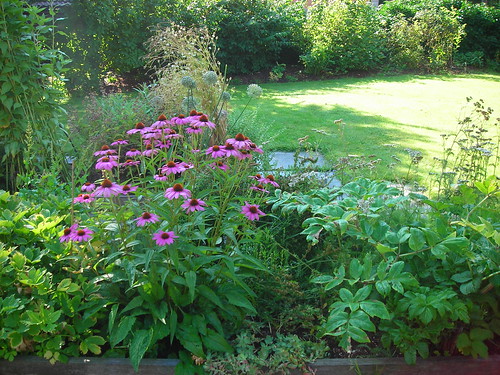
Another wonder herb--allium. This is one of those things that I'll probably be embarrassed by--but I'm not sure exactly what this is. I've read that onions and garlic are among the most beneficial foods we can eat. Almost everything I cook starts with garlic, onion, and red pepper (ok, so maybe not brownies). But I don't grow garlic or onions--this is some kind of garlic, right?

And I loved this flower! The Curmudgeon says it's a Saponaria. I've grown the kind called "Bouncing Bet," which is taller and pinker. This one is gorgeous--I think it might have been a volunteer in their tansy bed.
And could this be Gunnera? At first I thought Norway must be too cold, but then Bergen has a milder climate than we do in Eastern Virginia. I've never heard that Gunnera has a medicinal use, but this was the more ornamental edge of the garden--or, just as likely, I don't what the medicinal use is . . .
From the Leprosy Museum, I headed over to the Botanical Gardens--they're behind the Natural History Museum at the University of Bergen. I was there on an unusually sunny day--and like students in Virginia, the students in Bergen were making the most of it.
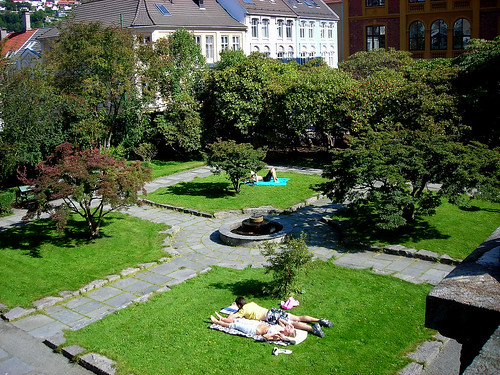
The gardens had a huge collection of Primula, a number of which I'd seen in other gardens. This long border is mostly Primula and ferns.
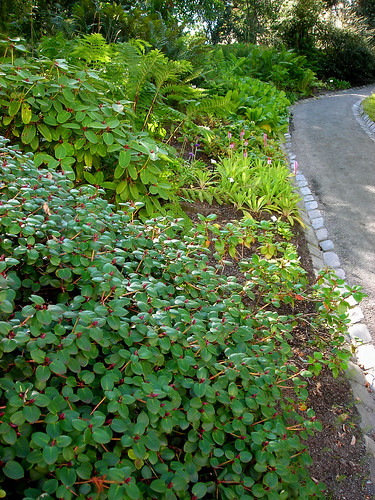
This one is Primula vialli . . .
This flower was in a bed of Rudbeckia, and again I couldn't find the label. I love it--is it possible it's Inula?
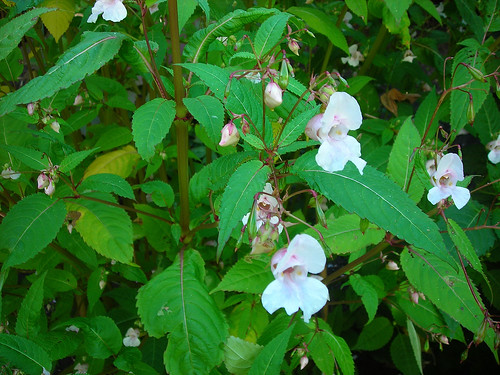
I was happy to see that, like me, the Botanical Gardeners occasionally missed a spot (or maybe they just want some things to go to seed?)--I loved these yellow flowers on the ornamental kale (it's kale, right?--I might actually get some if the flowers look like these).
I have grown cherry belles, but I never let them go--will they really get this big?
Anyway, the Botanical Gardens were lovely. These are very familiar plants--two of my favorite annuals, marigold and heliotrope--the arrangement falls under the category "why didn't I think of this?"
So I came away from my trip with some ideas for my garden next year--and I have been working in it (one reason, in this cooler weather, that I haven't been posting very regularly). I'll be back to my own flowers soon--after one more post on Europe--on Amsterdam's flower market--coming soon. Adjo, for now.


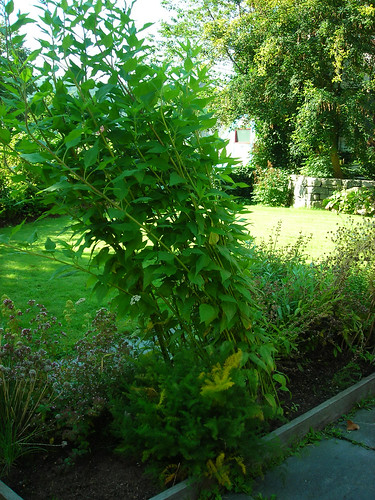

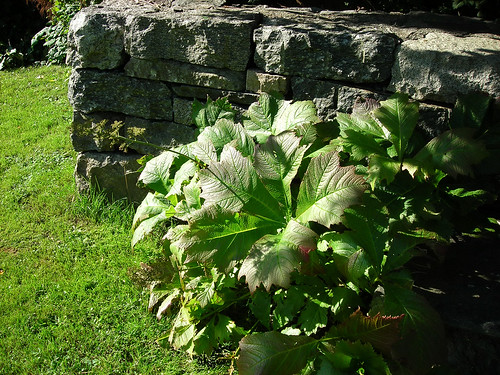
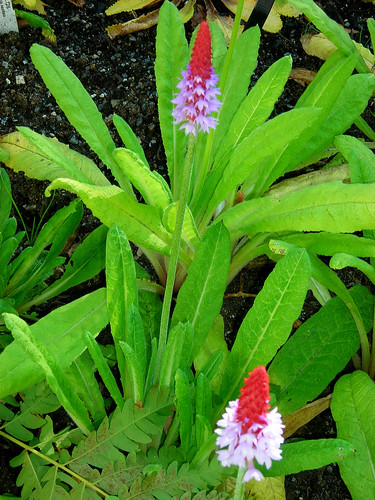

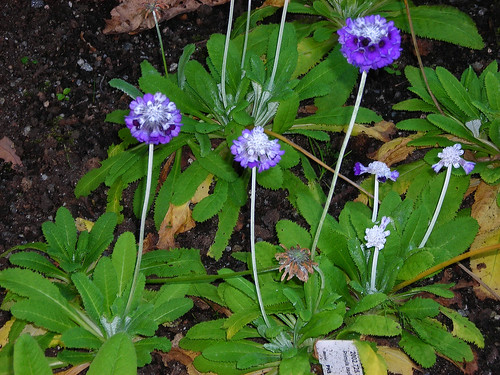
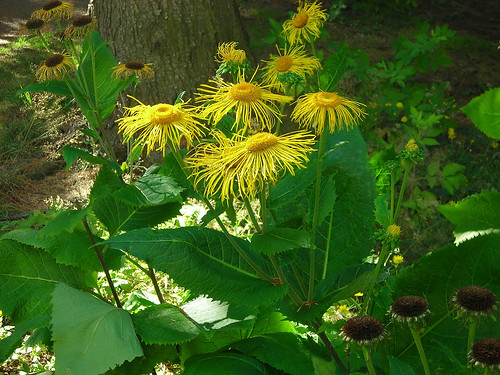



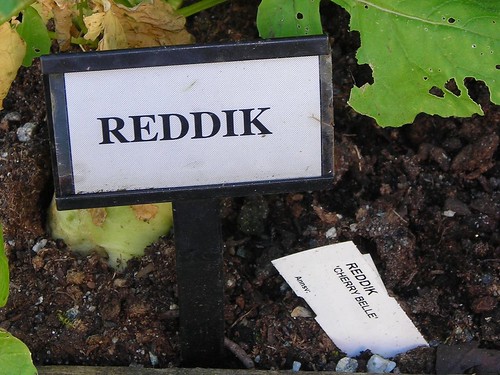
























17 comments:
That tourist knew the names of ALL the flowers. He said their names are, "Yummy, and Yummy two, and Yummy Three!" I don't even know the names to half of them and it is a good thing you do and some friends have helped you out. I think you were right on. I loved the primula/fern border. That is great. I wish my garden could look like this. Looking forward to post number three too!
What a great tour. I have to share that a Leprosy Museum seems quite odd but....If I had more sun I would have an herb garden like the one you described...lots of medicinal but beautiful plants!
BTW your photos are great!
gail
I agree with Gail. Not sure I would have gone to the Leprosy Museum, but am glad you did. the History Mueseum's flower gardens were lovely and such great picture. And don't be emarrased about not knowing names. I always have to look for the tags!
What a wonderful medicinal garden. I have Bouncing Bet too but mine is pink as well. I wouldn't of know the names of half that stuff either. I always take a picture of the tag after the flower, lol. :) And Tina is probably right about the visitor thinking yummy 1, 2 & 3. lol
Oh, I LOVE all of your great pictures! The golden flower is almost certainly an inula, and I think you're right on the gunnera, too... but I can't help you out on the unknown type of primrose. Although I do think that it's cute tnough to get me to try primroses again. :)
Oh, and I think that your funky allium is a "walking onion"... so called because those bulbs grow at the top, get heavy, and then bend over and touch the ground, where they will root and make more plants.
That's totally a hunch, though, so you might want to Google search and see if I'm on to anything. At the very least, it might point you off on a tangent that will help. (I hope!) :)
I loved seeing all your photos.
The herb garden was interesting. I've always wanted to have one, so I pay special attention to others.
The botanical gardens were fabulous. The primulas are so delicate and pretty. Some of my old standby favorites are heliotrope and marigolds;) The inula was certainly pretty.
Marnie
Who knew that a Leprosy Museum could be beautiful? I'll bet that Eupatorium is Joe Pye Weed, which got its name because Joe Pye used it to cure some ailment. (I wish I could remember half the stuff I've forgotten.)
Here's some info I found on Wiki..The stalks of G. tinctoria (nalcas) are edible. Their principal use is fresh consumption, but also they are prepared in salads, liquor or marmalade. Leaves of this species are used in covering curanto (a traditional Chilean food).
Gunnera perpensa is used as a source of traditional medicine in Southern Africa
It is also called Giant Rhubarb.
I love all these pictures and the back stories are fascinating. I always thought it was cold in Norway too.
Thanks for the fascinating tour. I left work early because of the weather and am finally catching up with everyone. I hope your garden is getting all this rain too. Things were so dry. It really suprises me about their climate, you always think of it as cold, dark and snowy during the winter.
Cosmo, you've already identified the only plants I know, so I'm no help either! I was reading along very naively, thinking about the names of these plants and wondering why you didn't mention the snail. It took me a short while to identify your "tourist":)
So interesting to see so many familiar plants in such a far-off place. The heliotrope and marigolds do look gorgeous together!
Tina, the line you gave the snail is great! I'd LOVE to do a primula border like that--it might be a little too hot, here, though.
Gail and Beckie, I know the Leprosy Museum seems like a strange place to visit, but it was really highly recommended and it was fascinating--I think Hansen's work was groundbreaking. But oh, it was great to get outside and see the plants--I hope some kind of garden was there for the patients.
Racquel--How does your Bouncing Bet do? Mine got floppy and weedy, so I didn't bring bring it with me when I moved. I do try to take pictures of the tags--but my framing isn't always very good!
Kim, thanks for the ID's! I did look up walking onions, and it sure looks like that's what those are--I think I might try some. I've never seen inula before--they were gorgeous in with the rudbeckia.
Marnie, I love herbs--they're not the first thing I ever grew (those were annuals on a patio), but they are the first thing I ever put in the ground. I've never gotten a good design, though--I grow them pretty haphazardly. Maybe some day I'll get it down!
MMD, I didn't know that about Joe Pye weed, but I looked it up, and yes, he used it to cure fevers (same thing the Native Americans used bneset for--makes sense, I guess, since they're in the same family). And I feel the same way about what I've forgotten (umm, like the names of many plants . . .)
Eve, thanks for the information about the Gunnera--I had no idea it was edible! I think it might be frost tender, and I know it needs lots of water--I'm not sure it would make it here, though it's so gorgeous.
Les, we are SO enjoying the rain. I hope your weather has stayed mildish--I guess they've had torandoes cropping up in NC. Here, it's just been steady rain.
Rose, it was neat finding familiar plants in such a different climate. It did produce some plant envy--I really loved the primroses, but I'm not sure they'll work here--but maybe I'll try one!
Everyone, thanks for joining me on my trip!
I love the neat pathway with the primroses. I also like the yellow flower - very striking blooms! Nice photos.
Amazing pictures, really looking forward to the Amsterdam post. You've made me want to visit the Leprosy Museum so kudos for that.
So if you are like most people you have had to deal with acne at some point in your life. Maybe you are experiencing it now as an adult when you had no problems during your teenage years or possibly it has been a persistent problem that hasn't stopped plaguing your everyday life. With a massive amount of acne remedies, lotions, creams and solutions on the market you may want to take a step back and really look at your acne problem for a moment. Most teens with acne will just grab any old acne solution off the shelf and try it to see if it works.
Fields of Flowers Flora Restore
The plant is commonly found in China and India in dry and arid conditions, especially the sandy desserts. The seeds contain essential oil, a nonvolatile terpenoid oil, a pigment, a resin, fixed oil, raffinose, two coumarin compounds viz., psoralen adn isopsoralen, psoralidin, corylifolean, isopsoralidin; and the most active ingredient is psoralin alkaloid.
Adrenogen Multigenics Intensive Care
Post a Comment